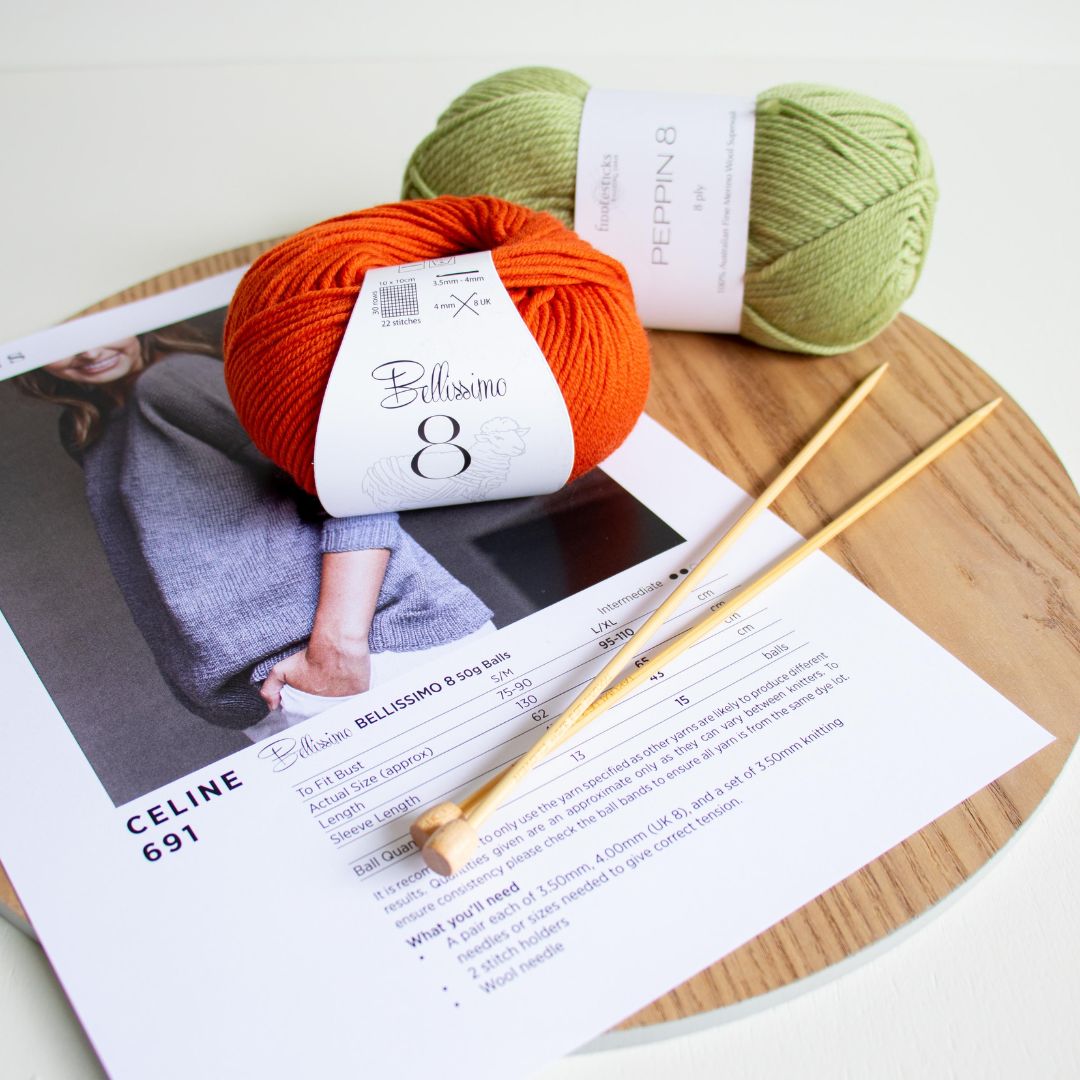You've found the perfect knitting or crochet pattern, but you'd like to use a different yarn to the one recommended in the pattern. When you're new to knitting or crocheting it can be confusing and intimidating navigating terminology and its implications, so here's an introduction to some of the considerations that might prove useful!
Yarns can vary in thickness (or ply), tension, ball weight, meterage (or yardage) and fibre content, so which of these is the most important consideration when substituting yarns? Let's use a knitting pattern featuring Bellissimo Extra Fine Merino 8 as an example:

Say I've decided to knit the S/M size. The pattern indicates that I need 13 balls of Bellissimo Extra Fine Merino 8 to complete the garment. Let's imagine that I'm particularly fond of a colour in another pure wool range, Fiddlesticks Peppin 8. The question is, "Can I substitute one yarn for another, and how do I make sure that I have enough yarn?"
Here are few basic things to consider when substituting yarn:
 We're not always that lucky with yarn, or may not have access to the suggested yarn, in which case, consider using a reliable online source, such as Ravelry, a free web site (although you may have to sign up to become a member), listing the important features of most commercially available yarns, including ply. Whichever yarn we hope to use as a substitute, it should ideally have the same ply as the suggested yarn. In this case, I'm interested in using Fiddlesticks Peppin Fine Merino 8 -
We're not always that lucky with yarn, or may not have access to the suggested yarn, in which case, consider using a reliable online source, such as Ravelry, a free web site (although you may have to sign up to become a member), listing the important features of most commercially available yarns, including ply. Whichever yarn we hope to use as a substitute, it should ideally have the same ply as the suggested yarn. In this case, I'm interested in using Fiddlesticks Peppin Fine Merino 8 -  I'm in luck! I've picked another 8 ply. So, what's next?
I'm in luck! I've picked another 8 ply. So, what's next?
The next thing to consider is the tension of the two yarns, or, in other words, the number of stitches and rows that will fit within a 10cm square of (in this case) Stocking Stitch knitting (one row of plain, followed by one row of purl, and so on), using the recommended knitting needle size. Keep in mind that yarns with the same ply can sometimes have slightly different tension recommendations, but that's OK! Particularly when working on garments, the pattern will often include terms such as , "repeat the last row until your piece measures..." a certain length - here you will have a degree of customisation, ensuring that the garment will fit the intended wearer.
The suggested tension is usually found on a yarn's label. In Bellissimo's case it looks like this-  Let's consider knitting (or crochet) tension, and what it means. Tension is simply a way of describing the firmness or looseness of your knitting or crochet. Think of "Goldilocks and the Three Bears" - we aim for our tension to be not too tight, not too loose, but "just right"! The suggested tension on this yarn label tells us that if we use 4mm knitting needles, cast on 22 stitches, then knit (in Stocking Stitch) 30 rows, the resulting square should measure 10cm x 10cm, if our tension is correct. If your knitted square (called a "tension square") is bigger than 10cm x 10cm, your tension is loose, and you'll need to use a slightly smaller needle to achieve the correct tension. The reverse will apply if your tension square is smaller than 10cm x 10cm. In this case, your knitting is too tight, so you'll need to try a slightly larger needle to achieve the correct tension. With this in mind, our substitution yarn should ideally have the same recommended tension. In the case of Fiddlesticks Peppin Fine Merino 8, it looks like this:
Let's consider knitting (or crochet) tension, and what it means. Tension is simply a way of describing the firmness or looseness of your knitting or crochet. Think of "Goldilocks and the Three Bears" - we aim for our tension to be not too tight, not too loose, but "just right"! The suggested tension on this yarn label tells us that if we use 4mm knitting needles, cast on 22 stitches, then knit (in Stocking Stitch) 30 rows, the resulting square should measure 10cm x 10cm, if our tension is correct. If your knitted square (called a "tension square") is bigger than 10cm x 10cm, your tension is loose, and you'll need to use a slightly smaller needle to achieve the correct tension. The reverse will apply if your tension square is smaller than 10cm x 10cm. In this case, your knitting is too tight, so you'll need to try a slightly larger needle to achieve the correct tension. With this in mind, our substitution yarn should ideally have the same recommended tension. In the case of Fiddlesticks Peppin Fine Merino 8, it looks like this:  Yippee! We have a perfect match! The tension of the two yarns is exactly the same, so we're on the right track.
Yippee! We have a perfect match! The tension of the two yarns is exactly the same, so we're on the right track.
OK, so far so good. The next thing we need to consider is the meterage (or yardage) of the yarn. In my experience, the reason why people either run out of yarn, or end up having too much at the end of the project, is that they have used the weight of the ball of yarn as their first consideration, and not the meterage. This is where the composition of the yarn is important. Generally speaking, acrylic yarn will have more meterage per 50 grams than its equivalent ply in a fibre such as pure wool, although the finer the grade of wool (as is the case with merino), the more meterage the yarn should have.
Let's go back to our two yarns to work out what we'll need. If we look at our ball of Bellissimo, we can see from the label that it has 125 meters per 50 gram ball. That's quite a bit of meterage for 8 ply pure wool (and indicates the quality of the merino - a pure wool of less quality will, generally speaking, have a much lower meterage).
 Returning to our pattern, we can see that it calls for 13 balls of Bellissimo 8 to knit the size I was after. To work out the required meterage is fairly straight forward - we simply multiply the number of balls by the meterage found in one ball of the yarn.
Returning to our pattern, we can see that it calls for 13 balls of Bellissimo 8 to knit the size I was after. To work out the required meterage is fairly straight forward - we simply multiply the number of balls by the meterage found in one ball of the yarn.
In this case, we need 13 balls, each with 125m, so that will be 13 x 125 = 1625m. Keep in mind that most patterns are fairly generous with their yarn recommendations, and will round up to the next number. So, let's take a look at the meterage of the Fiddlesticks Peppin Fine Merino 8 we wish to use:  We can see that one ball of Fiddlesticks Peppin Fine Merino 8 has 110 meters per 50 gram ball. To work out how many balls we'll need of this yarn to complete the garment, we need to take the overall pattern meterage (in this case 1625m), and divide it by the meterage of our substitution yarn (in this case, 110m).
We can see that one ball of Fiddlesticks Peppin Fine Merino 8 has 110 meters per 50 gram ball. To work out how many balls we'll need of this yarn to complete the garment, we need to take the overall pattern meterage (in this case 1625m), and divide it by the meterage of our substitution yarn (in this case, 110m).
So that will be 1625 ÷ 110 = 14.77. So in this case we'll need 15 balls of the Peppin 8 Ply to complete the garment. You can see the problem faced when substituting one yarn for another: if we only considered the correct ply, and the size (in weight) of the yarns, we would have been 2 balls short!
That leaves us with one more important consideration.
Fibre Content: the fibre content of a yarn can have a great bearing on the finish of any knitted or crocheted garment. Keep in mind that most designers will have a particular yarn in mind, and will design their garment with knowledge of the attributes of that particular yarn. You'll notice that many patterns will warn against substituting yarns, indicating that other yarns may give different, if not disappointing, results. Some fibres are denser than others, so despite having the same ply and tension, may yield different results in terms of loft, drape and shape. For instance, pure cottons are generally heavier than most wools, will have less meterage per ball, so will require more yarn. As a result, the garment will also be heavier, and may lose some of its original appeal. So when deciding to use a yarn with a completely different fibre content to that suggested by the pattern, keep in mind that the look and feel of the garment may differ substantially. When in doubt, knit or crochet a tension square to see if you like the effect before committing to the project.
I hope this helps! Until next time,
Happy Crafting!
Michelle.

